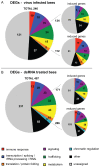Non-specific dsRNA-mediated antiviral response in the honey bee
- PMID: 24130869
- PMCID: PMC3795074
- DOI: 10.1371/journal.pone.0077263
Non-specific dsRNA-mediated antiviral response in the honey bee
Abstract
Honey bees are essential pollinators of numerous agricultural crops. Since 2006, honey bee populations have suffered considerable annual losses that are partially attributed to Colony Collapse Disorder (CCD). CCD is an unexplained phenomenon that correlates with elevated incidence of pathogens, including RNA viruses. Honey bees are eusocial insects that live in colonies of genetically related individuals that work in concert to gather and store nutrients. Their social organization provides numerous benefits, but also facilitates pathogen transmission between individuals. To investigate honey bee antiviral defense mechanisms, we developed an RNA virus infection model and discovered that administration of dsRNA, regardless of sequence, reduced virus infection. Our results suggest that dsRNA, a viral pathogen associated molecular pattern (PAMP), triggers an antiviral response that controls virus infection in honey bees.
Conflict of interest statement
Figures





References
-
- Runckel C, Flenniken ML, Engel JC, Ruby JG, Ganem D, et al. (2011) Temporal analysis of the honey bee microbiome reveals four novel viruses and seasonal prevalence of known viruses, Nosema, and Crithidia, *co-first authors. PLOS ONE 6: e20656. doi:10.1371/journal.pone.0020656. PubMed: 21687739. - DOI - PMC - PubMed
Publication types
MeSH terms
Substances
Grants and funding
LinkOut - more resources
Full Text Sources
Other Literature Sources

